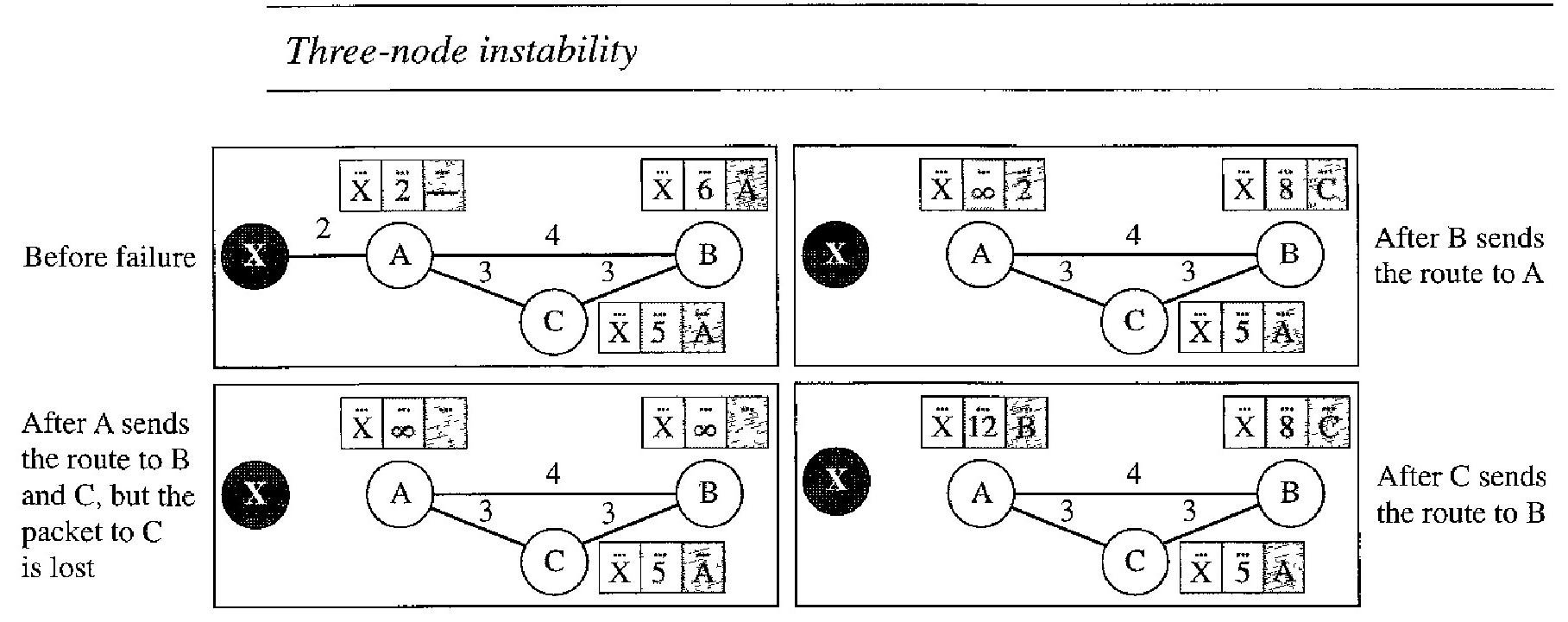Network Layer: Routing Table
A host or a router has a routing table with an entry for each destination, or a combination of destinations, to route IP packets. The routing table can be either static or dynamic.
Static Routing Table : A static routing table contains information entered manually. The administrator enters the route for each destination into the table. When a table is created, it cannot update automatically when there is a change in the Internet. The table must be manually altered by the administrator. A static routing table can be used in a small internet that does not change very often, or in an experimental internet for troubleshooting. It is poor strategy to use a static routing table in a big internet.
Dynamic Routing Table : A dynamic routing table is updated periodically by using one of the dynamic routing protocols such as RIP, OSPF, or BGP. Whenever there is a change in the Internet, such as a shutdown of a router or breaking of a link, the dynamic routing protocols update all the tables in the routers (and eventually in the host) automatically. The routers in a big internet such as the Internet need to be updated dynamically for efficient delivery of the IP packets.
Format of routing table for classless addressing
A routing table for classless addressing has a minimum of four columns. However, some of today's routers have even more columns. We should be aware that the number of columns is vendor-dependent, and not all columns can be found in all routers.
Common fields in a routing table
Mask : This field defines the mask applied for the entry.
Network address : This field defines the network address to which the packet is finally delivered. In the case of host-specific routing, this field defines the address of the destination host.
Next-hop address : This field defines the address of the next-hop router to which the packet is delivered.
Interface : This field shows the name of the interface.
Flags : This field defines up to five flags. Flags are on/off switches that signify either presence or absence. The five flags are U (up), G (gateway), H (host-specific), D (added by redirection), and M (modified by redirection).
U (up) The U flag indicates the router is up and running. If this flag is not present, it means that the router is down. The packet cannot be forwarded and is discarded. G (gateway) : The G flag means that the destination is in another network. The packet is delivered to the next-hop router for delivery (indirect delivery). When this flag is missing, it means the destination is in this network (direct delivery). H (host-specific) : The H flag indicates that the entry in the network address field is a host-specific address. When it is missing, it means that the address is only the network address of the destination. D (added by redirection) : The D flag indicates that routing information for this destination has been added to the host routing table by a redirection message from ICMP. M (modified by redirection) The M flag indicates that the routing information for this destination has been modified by a redirection message from ICMP.
Reference count : This field gives the number of users of this route at the moment. For example, if five people at the same time are connecting to the same host from this router, the value of this column is 5.
Use : This field shows the number of packets transmitted through this router for the corresponding destination.
UNICAST ROUTING PROTOCOLS
A routing table can be either static or dynamic. A static table is one with manual entries. A dynamic table, on the other hand, is one that is updated automatically when there is a change somewhere in the internet.
Routing protocols have been created in response to the demand for dynamic routing tables. A routing protocol is a combination of rules and procedures that lets routers in the internet inform each other of changes.
It allows routers to share whatever they know about the internet or their neighborhood. The sharing of information allows a router in Mumbai to know about the failure of a network in Delhi. The routing protocols also include procedures for combining information received from other routers.
Optimization
A router receives a packet from a network and passes it to another network. A router is usually attached to several networks. When it receives a packet, to which network should it pass the packet? The decision is based on optimization: Which of the available pathways is the optimum pathway?
One approach is to assign a cost for passing through a network. We call this cost a metric. However, the metric assigned to each network depends on the type of protocol. Some simple protocols, such as the Routing Information Protocol (RIP), treat all networks as equals.
The cost of passing through a network is the same; it is one hop count. So if a packet passes through 10 networks to reach the destination, the total cost is 10 hop counts.
Other protocols, such as Open Shortest Path First (OSPF), allow the administrator to assign a cost for passing through a network based on the type of service required. A route through a network can have different costs (metrics).
For example, if maximum throughput is the desired type of service, a satellite link has a lower metric than a fiber-optic line. On the other hand, if minimum delay is the desired type of service, a fiber-optic line has a lower metric than a satellite link.
Routers use routing tables to help decide the best route. OSPF protocol allows each router to have several routing tables based on the required type of service.
Other protocols define the metric in a totally different way. In the Border Gateway Protocol (BGP), the criterion is the policy, which can be set by the administrator. The policy defines what paths should be chosen.
Intra- and Interdomain Routing
Today, an internet can be so large that one routing protocol cannot handle the task of updating the routing tables of all routers. For this reason, an internet is divided into autonomous systems.
An autonomous system (AS) is a group of networks and routers under the authority of a single administration. Routing inside an autonomous system is referred to as intradomain routing.
Routing between autonomous systems is referred to as interdomain routing. Each autonomous system can choose one or more intrado- main routing protocols to handle routing inside the autonomous system. However, only one interdomain routing protocol handles routing between autonomous systems.
Popular routing protocols
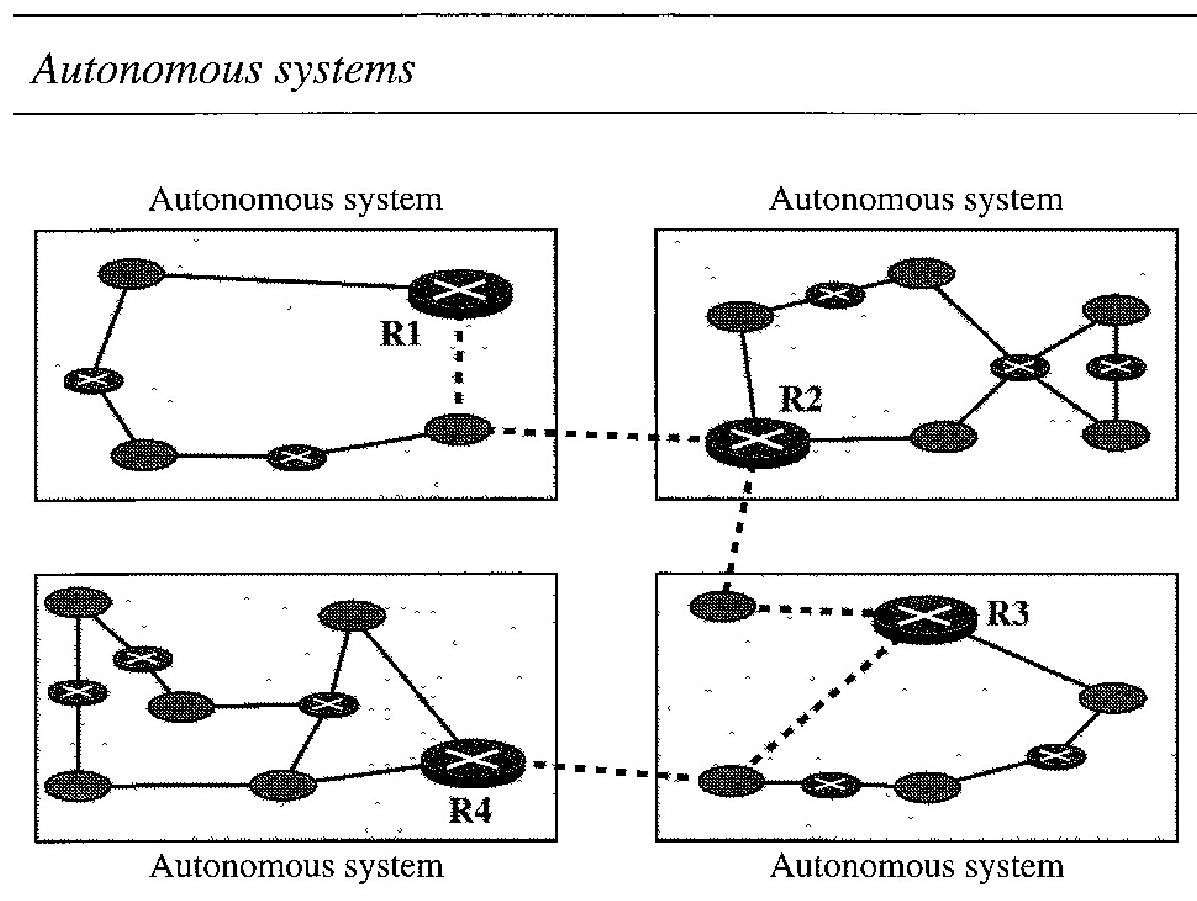
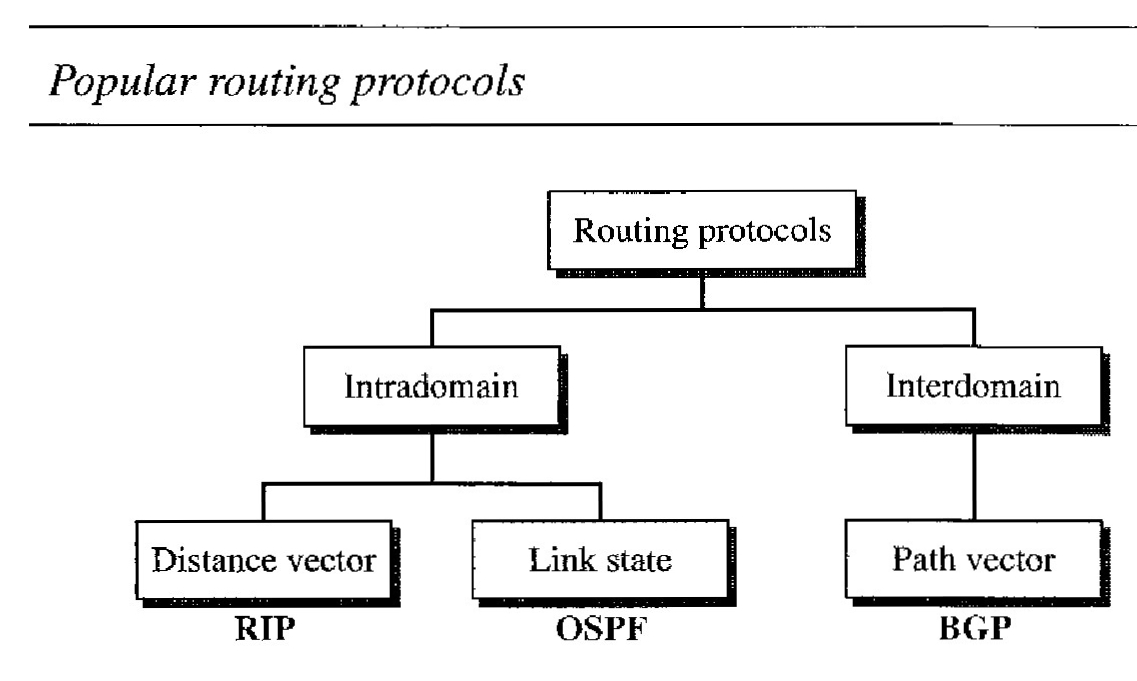
Distance Vector Routing
In distance vector routing, the least-cost route between any two nodes is the route with minimum distance. In this protocol, as the name implies, each node maintains a vector (table) of minimum distances to every node. The table at each node also guides the packets to the desired node by showing the next stop in the route (next-hop routing).
We can think of nodes as the cities in an area and the lines as the roads connecting them. A table can show a tourist the minimum distance between cities.
In Figure below, we show a system of five nodes with their corresponding tables :
The table for node A shows how we can reach any node from this node. For example, our least cost to reach node E is 6. The route passes through C.
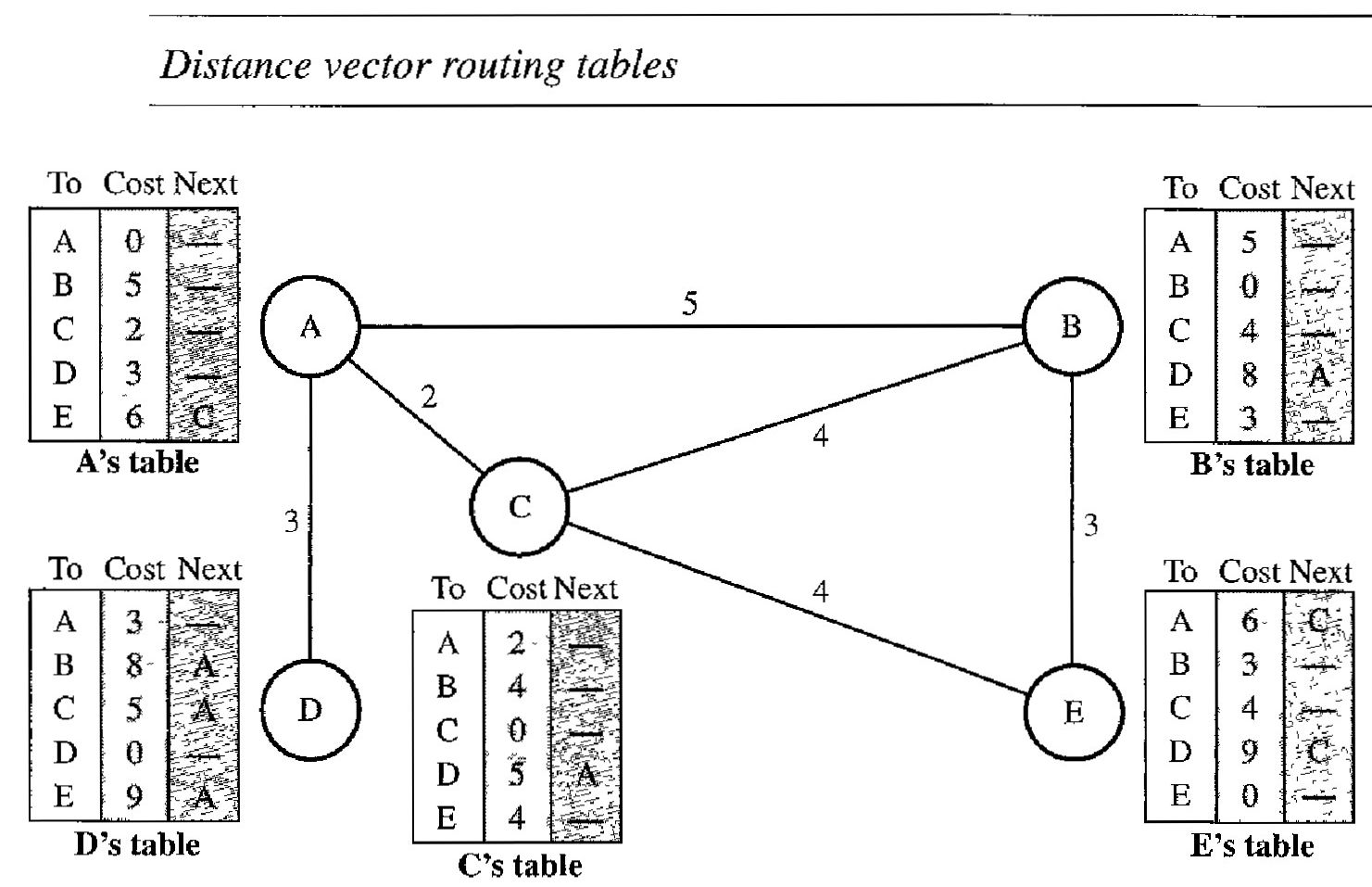
Distance Vector Routing - Initialization
At the beginning, Each node can know only the distance between itself and its immediate neighbors, those directly connected to it. So for the moment, we assume that each node can send a message to the immediate neighbors and find the distance between itself and these neighbors. Figure below shows the initial tables for each node. The distance for any entry that is not a neighbor is marked as infinite (unreachable).
Sharing : Although node A does not know about node E, node C does. So if node C shares its routing table with A, node A can also know how to reach node E. On the other hand, node C does not know how to reach node D, but node A does. If node A shares its routing table with node C, node C also knows how to reach node D. In other words, nodes A and C, as immediate neighbors, can improve their routing tables if they help each other.
Each node is to send its entire table to the neighbor and let the neighbor decide what part to use and what part to discard. However, the third column of a table (next stop) is not useful for the neighbor. When the neighbor receives a table, this column needs to be replaced with the sender's name. If any of the rows can be used, the next node is the sender of the table. A node therefore can send only the first two columns of its table to any neighbor. In other words, sharing here means sharing only the first two columns.
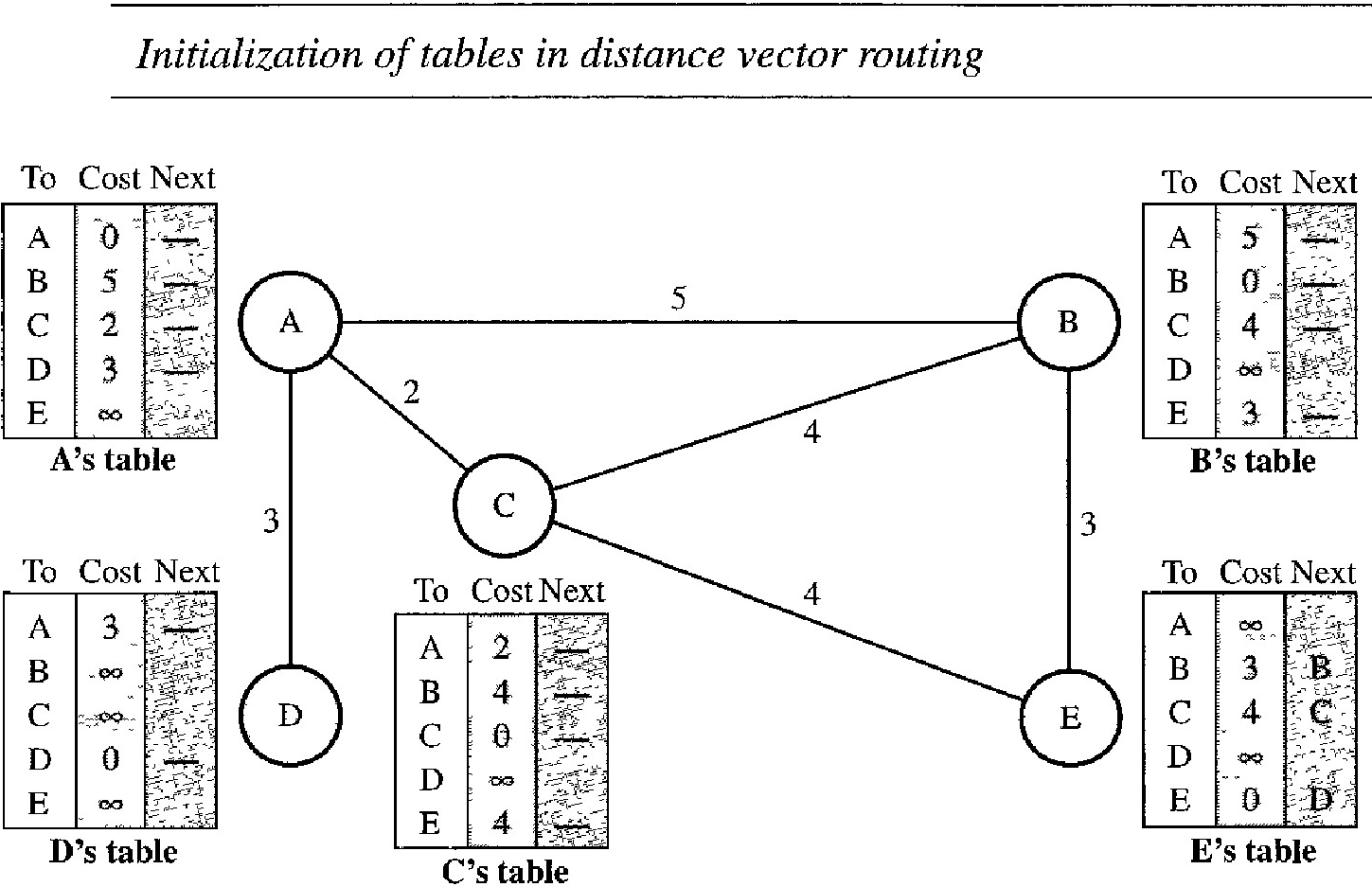
Distance Vector Routing - Updating
When a node receives a two-column table from a neighbor, it needs to update its routing table. Updating takes three steps:
The receiving node needs to add the cost between itself and the sending node to each value in the second column. The logic is clear. If node C claims that its distance to a destination is x mi, and the distance between A and C is y mi, then the distance between A and that destination, via C, is x + y mi.
The receiving node needs to add the name of the sending node to each row as the third column if the receiving node uses information from any row. The sending node is the next node in the route.
The receiving node needs to compare each row of its old table with the corresponding row of the modified version of the received table.
If the next-node entry is different, the receiving node chooses the row with the smaller cost. If there is a tie, the old one is kept.
If the next-node entry is the same, the receiving node chooses the new row. For example, suppose node C has previously advertised a route to node X with distance 3. Suppose that now there is no path between C and X; node C now adver- tises this route with a distance of infinity. Node A must not ignore this value even though its old entry is smaller. The old route does not exist any more. The new route has a distance of infinity.
Figure below shows how node A updates its routing table after receiving the partial table from node C.
There are several points we need to emphasize here. First, as we know from mathematics, when we add any number to infinity, the result is still infinity. Second, the modified table shows how to reach A from A via C. If A needs to reach itself via C, it needs to go to C and come back, a distance of 4. Third, the only benefit from this updating of node A is the last entry, how to reach E. Previously, node A did not know how to reach E (distance of infinity); now it knows that the cost is 6 via C.
Each node can update its table by using the tables received from other nodes. In a short time, if there is no change in the network itself, such as a failure in a link, each node reaches a stable condition in which the contents of its table remains the same.
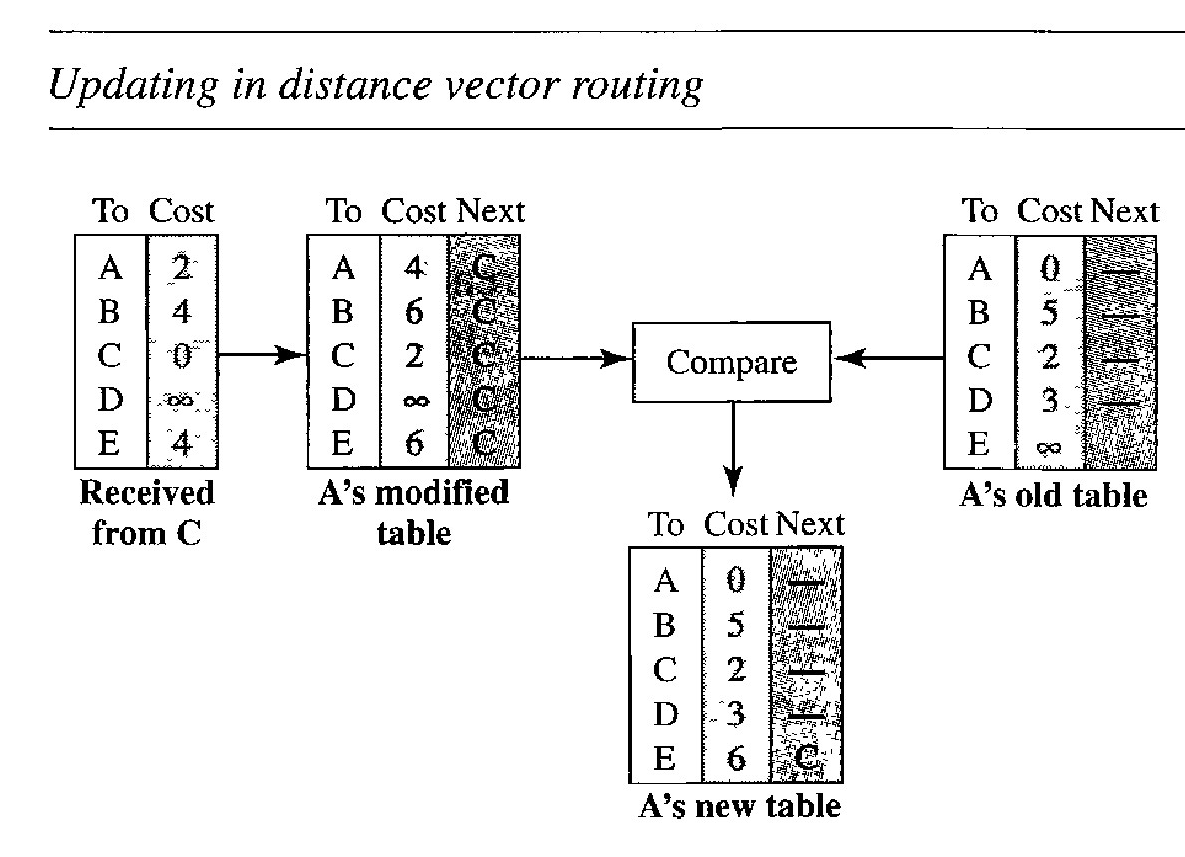
Points to Remember about Distance Vector Routing
When does a node send its partial routing table (only two columns) to all its immediate neighbors? The table is sent both periodically and when there is a change in the table.
Periodic Update : A node sends its routing table, normally every 30 s, in a periodic update. The period depends on the protocol that is using distance vector routing.
Triggered Update : A node sends its two-column routing table to its neighbors anytime there is a change in its routing table. This is called a triggered update. The change can result from the following. A node receives a table from a neighbor, resulting in changes in its own table after updating. A node detects some failure in the neighboring links which results in a distance change to infinity.
Two-Node Loop Instability
At the beginning, both nodes A and B know how to reach node X. But suddenly, the link between A and X fails.
Node A changes its table. If A can send its table to B immediately, everything is fine. However, the system becomes unstable if B sends its routing table to A before receiving A's routing table.
Node A receives the update and, assuming that B has found a way to reach X, immediately updates its routing table. Based on the triggered update strategy, A sends its new update to B.
Now B thinks that something has been changed around A and updates its routing table. The cost of reaching X increases gradually until it reaches infinity. At this moment, both A and B know that X cannot be reached. However, during this time the system is not stable.
Node A thinks that the route to X is via B; node B thinks that the route to X is via A. If A receives a packet destined for X, it goes to B and then comes back to A. Similarly, if B receives a packet destined for X, it goes to A and comes back to B. Packets bounce between A and B, creating a two-node loop problem.
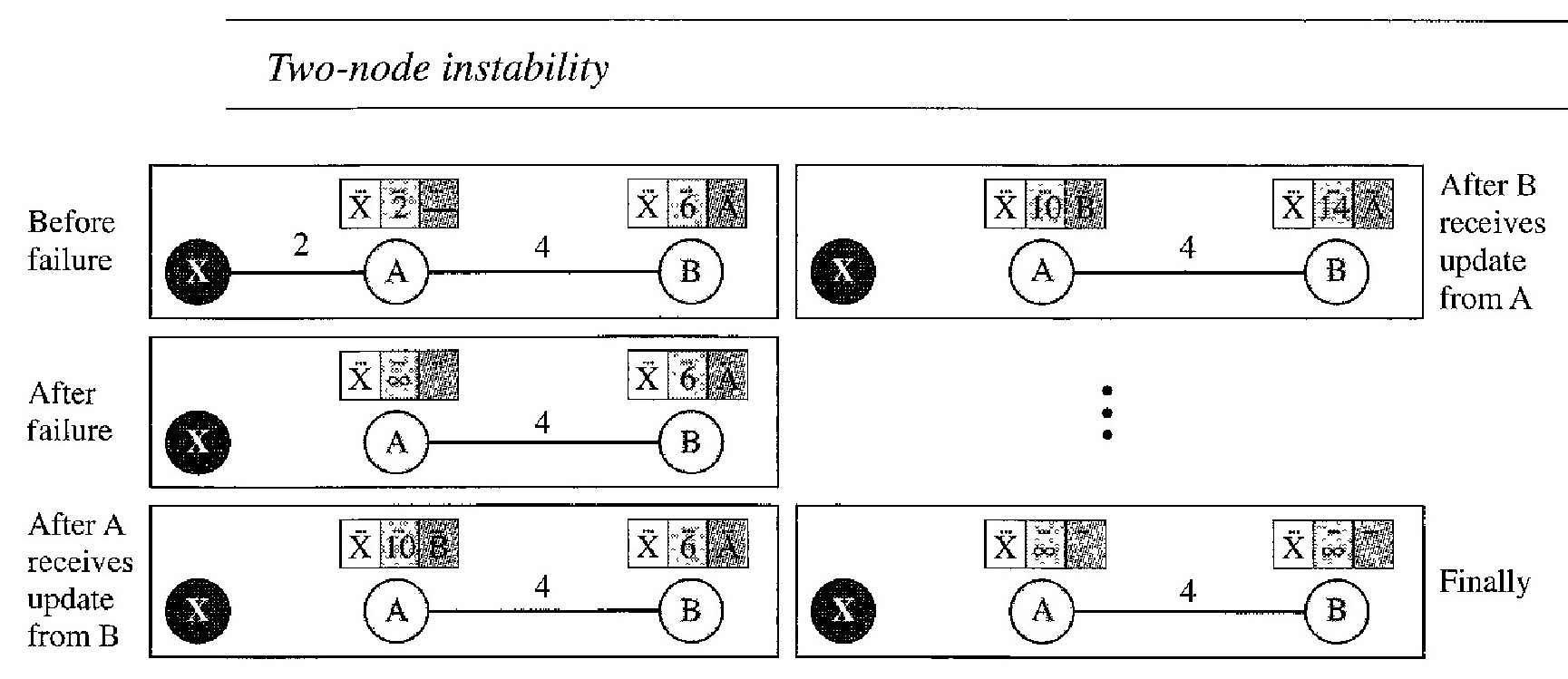
Solutions for Two-Node Loop Instability
Defining Infinity : The first obvious solution is to redefine infinity to a smaller number, such as 100. For our previous scenario, the system will be stable in less than 20 updates. As a matter of fact, most implementations of the distance vector protocol define the distance between each node to be 1 and define 16 as infinity. However, this means that the distance vector routing cannot be used in large systems. The size of the network, in each direction, can not exceed 15 hops.
Split Horizon :
In this strategy, instead of flooding the table through each interface, each node sends only part of its table through each interface.
If, according to its table, node B thinks that the optimum route to reach X is via A, it does not need to advertise this piece of information to A; the information has come from A (A already knows).
Taking information from node A, modifying it, and sending it back to node A creates the confusion. In our scenario, node B eliminates the last line of its routing table before it sends it to A. In this case, node A keeps the value of infinity as the distance to X. Later when node A sends its routing table to B, node B also corrects its routing table. The system becomes stable after the first update: both node A and B know that X is not reachable.
Split Horizon and Poison Reverse
Using the split horizon strategy has one drawback. Normally, the distance vector protocol uses a timer, and if there is no news about a route, the node deletes the route from its table.
When node B in the previous scenario eliminates the route to X from its advertisement to A, node A cannot guess that this is due to the split horizon strategy (the source of information was A) or because B has not received any news about X recently.
The split horizon strategy can be combined with the poison reverse strategy. Node B can still advertise the value for X, but if the source of information is A, it can replace the distance with infinity as a warning: "Do not use this value; what I know about this route comes from you."
Three-Node Instability
The two-node instability can be avoided by using the split horizon strategy combined with poison reverse. However, if the instability is between three nodes, stability cannot be guaranteed.
Suppose, after finding that X is not reachable, node A sends a packet to Band C to inform them of the situation. Node B immediately updates its table, but the packet to C is lost in the network and never reaches C. Node C remains in the dark and still thinks that there is a route to X via A with a distance of 5.
After a while, node C sends to B its routing table, which includes the route to X. Node B is totally fooled here. It receives information on the route to X from C, and according to the algorithm, it updates its table, showing the route to X via C with a cost of 8.
This information has come from C, not from A, so after awhile node B may advertise this route to A. Now A is fooled and updates its table to show that A can reach X via B with a cost of 12. Of course, the loop continues; now A advertises the route to X to C, with increased cost, but not to B. Node C then advertises the route to B with an increased cost. Node B does the same to A. And so on. The loop stops when the cost in each node reaches infinity.
